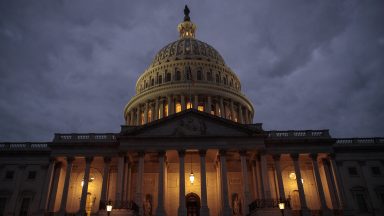

A government shutdown occurs when Congress fails to pass the necessary funding legislation for the federal government’s operations, or when the President refuses to sign such legislation into law.
Here are some of the main reasons why it happens:
- Budget Disputes: Shutdowns often occur when there is a disagreement between Congress members or between Congress and the President on specific spending priorities, such as defense, healthcare, social programs, or immigration policies.
- Political Strategy: Sometimes, shutdowns are used as a political strategy or bargaining chip to push for or against certain legislative measures. One party may use the threat of a shutdown to gain leverage in budget negotiations.
- Debt Ceiling Debates: Although the debt ceiling itself is separate from the budget process, debates over raising it have sometimes led to government shutdowns when an agreement could not be reached.
The Current Proposal
Senate Majority Leader Chuck Schumer (D-N.Y.) announced Thursday, Sept. 19 that he would take steps later in the day to advance a bipartisan government funding bill after Speaker Mike Johnson (R-La.) failed to pass a partisan six-month funding measure tied to voter registration reform.
“Later today, I’ll file cloture on a legislative vehicle that will enable us to prevent a Trump shutdown in the event that the Speaker does not work with us in a bipartisan, bicameral manner. Both sides are going to spend the next few days trying to figure out the best path remaining for keeping the government open,” Schumer said on the Senate floor.
The House vote on the spending plan ended with a 202-220 defeat, as 14 Republicans joined nearly all Democrats in voting against it. The plan paired a six-month stopgap funding bill with the Safeguard American Voter Eligibility Act, which would require proof of citizenship to register to vote. Two members voted present, while three Democrats crossed the aisle to support the measure.
Johnson, under pressure from Trump and right-wing members, proposed the plan despite opposition from Democrats. Democrats pointed out that it is already illegal for non-citizens to vote in U.S. federal elections and cited studies showing no evidence of widespread illegal voting. Critics also argued that the bill could deter some Americans from voting due to limited access to documents like passports or birth certificates.
Trump, emphasizing his support for the SAVE Act, wrote on Truth Social, “If Republicans don’t get the SAVE Act, and every ounce of it, they should not agree to a Continuing Resolution in any way, shape, or form.”
Schumer and Senate Appropriations Committee Chair Patty Murray (D-Wash.) issued a joint statement earlier in September, warning, “If Speaker Johnson drives House Republicans down this highly partisan path, the odds of a shutdown go way up, and Americans will know that the responsibility for a shutdown will be on the House Republicans’ hands.”
What Does the Shutdown Affect?
Most federal agencies must halt non-essential operations, close national parks, furlough employees, and suspend services until a new funding agreement is reached. Essential services—such as national security, law enforcement, and emergency medical care—continue to operate, but many government activities are paused.
During a furlough, hundreds of thousands of federal employees are placed on temporary leave without pay, while essential workers are required to work without pay until the shutdown is resolved.
A prolonged shutdown can also slow economic growth, impact the stock market, and create uncertainty in both domestic and international markets.
When Was the Last Government Shutdown?
Government shutdowns are not uncommon in U.S. history. Here’s a look at the most recent ones:
- 2018-2019: The longest government shutdown in U.S. history lasted 35 days, from December 22, 2018, to January 25, 2019. This shutdown was primarily due to disagreements over funding for a border wall between the U.S. and Mexico.
- 2018: Earlier in 2018, there was a brief shutdown from January 20 to January 22, mainly due to disagreements over immigration policy, including the Deferred Action for Childhood Arrivals (DACA) program.
- 2013: Lasting 16 days from October 1 to October 17, this shutdown was caused by a standoff over the Affordable Care Act (Obamacare) and budgetary concerns.
- 1995-1996: A significant shutdown lasted from December 16, 1995, to January 6, 1996, driven by disputes over Medicare, public health, and education funding.
